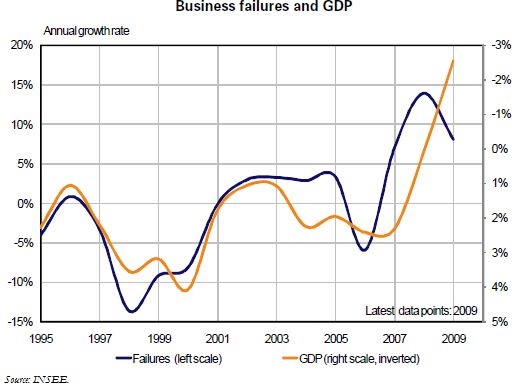Trésor-Economics No. 84 - Explanatory factors for recent trends in French business failures: an econometric analysis
The monthly index of business failures released by INSEE (France's National Statistical Institute) measures the number of enterprises for which a court-ordered reorganization has been initiated. Although it does not cover all terminations, the index-besides supplying information on business demography-acts as a reliable barometer of the financial health of firms. In particular, it helps to identify the determinants of business failures in the recent economic crisis.
Using a vector error-correction model linking failures, business creations, and GDP, we find that the pattern of business failures is rather well explained by two factors: a short-term factor, summarized by GDP, and a demographic factor, summarized by past business creations. The causal analysis shows that (1) GDP has a short-term negative influence on business failures (more firms fail in an economic downturn) and (2) business creations have a long-term influence on business failures (the more enterprises are created, the more some of them are likely to be terminated later).
The sharp increase in failures between 2007 and 2009 was admittedly due to the economic crisis, but is also explained by the demographic effect of the business-creation wave of 2003-2007 (notably stimulated by the Dutreil Acts). In 2008, the main cause of the rise in failures was a demographic effect.
In 2009, the demographic effect played a lesser role: the trend in failures was chiefly determined by a macroeconomic effect. However, thanks to the economic stimulus package and measures to support cash flow, the increase in failures in 2009 proved milder than the severity of the economic crisis and the past vigor of business creations would have led one to expect.
Conversely, failures-which, by definition, concern only firms and exclude self-entrepreneurs-continued to run high in first-half 2010 despite the economic upturn and the more favorable demographics. There are two likely causes: first, the expiration of stimulus measures designed to support cash flow; second, the introduction of the "self-entrepreneur" status.
